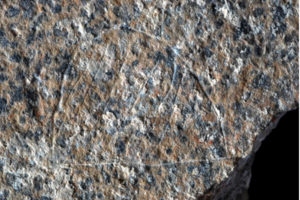What was life like for hunter gatherers? 13,800-year-old sketch offers clues.
Researchers found a landscape sketching by a 13,800-year-old Paleolithic artist, changing the way experts think of ancient humans' settlements and artistic ability.

A close-up of one of the seven hut motifs.
Marcos Garcia-Diez and Manuel Vaquero
Researchers have discovered a 13,800-year-old slab of stone that probably holds one of the earliest depictions of a hunter-gatherer camp ever discovered.
The art of prehistoric peoples can serve as a window into the past, revealing clues about how our ancestors lived and how societies developed. This latest discovery adds new dimension to our understanding of early communities.
Archeologists unearthed the ancient engraving in 2013 at the Moli del Salt site in Spain, located roughly 30 miles west of Barcelona. Dating back to the upper Paleolithic era, archaeologists Marcos Garcia-Diez and Manuel Vaquero say this discovery is exciting because it breaks with past artistic trends during the period.
“We think that someone was experimenting with new themes, focusing for the first time on the social realm,” the authors wrote in an email to the Los Angeles Times.
Until now, experts believed that “landscapes and features of the everyday world were scarcely represented in Paleolithic art,” and prehistoric artists instead focused on “other figurative motifs (especially animals) and signs,” traditionally linked to magical or religious themes of the Upper Paleolithic period, the researchers wrote in an article published Wednesday in the open-source scientific journal PLOS One.
Experts say the seven semi-circle huts depicted were probably sketched quickly one after the other with a sharp object slab that measures seven inches wide and three inches high.
So what do tent sketches on a slab of old rock tell us about human history?
“Campsites can be considered the first human landscape, the first area of land whose visible features were entirely constructed by humans,” Professors Garcia-Diez and Vaquero write in the paper. “Given the social meaning of campsites in the hunter-gatherer life-styles, this engraving may be considered one of the first representations of the domestic and social space of a human group.”
Specifically, the sketches give historians greater insight into huts’ morphology, proportions and frequency during the Paleolithic time period.
Dome-shaped structures can be built quickly, thus appealing to early hunter-gather societies who required short-term campsites. The authors say the dome shape of the seven tents is noteworthy because it suggests that the hunter-gatherers during this time period favored a seasonal and mobile settlement system. Artistic depictions of settlements become more common about 2,000 years later, when sedentary communities appear in the Neolithic time period.
The sketches also teach experts about hut proportions, suggesting Paleolithic settlers during this period built domed dwellings that were wider than they are high.
Finally, the seven huts depicted on the stone reinforce previous assumptions regarding band sizes of mobile people during the early Paleolithic period. The number of dwelling structures in a camp is highly variable, dependent on the “socio-economical organization” and food resources. The artist’s seven huts “fit perfectly” with previous predictions of population sizes in hunter-gatherer systems.
But most importantly, the 13,800-year-old discovery acts to humanize early human ancestors.
“Unlike other purported examples of landscape depictions,” the authors write, “it mainly represents a human landscape, suggesting that the human world was the main concern of the artist.”

